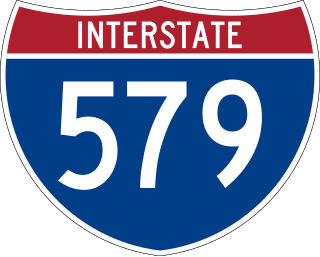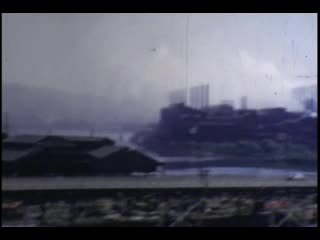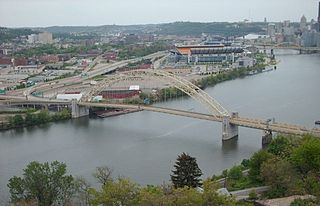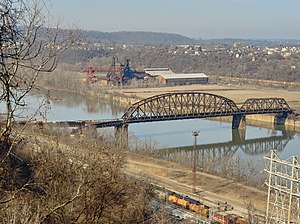The Monongahela Connecting Railroad or Mon Conn is a three-mile industrial railroad line in Pittsburgh, Pennsylvania. It was a subsidiary of the Jones & Laughlin Steel Company and a large portion of its work was for its parent company, though it also serves other industries along the line.

Interstate 579 (I-579) is a north–south Interstate Highway entirely within Pittsburgh, Pennsylvania. The highway is 2.73 miles (4.39 km) long. I-579 is also known as the Crosstown Boulevard since it crosses the backside of Downtown Pittsburgh.

The Great Allegheny Passage (GAP) is a 150-mile (240 km) rail trail between Pittsburgh, Pennsylvania and Cumberland, Maryland. Together with the C&O Canal towpath, the GAP is part of a 335 mi (539 km) route between Pittsburgh and Washington, D.C., that is popular with through hikers and cyclists.
The Pittsburgh and Lake Erie Railroad, also known as the "Little Giant", was formed on May 11, 1875. Company headquarters were located in Pittsburgh, Pennsylvania. The line connected Pittsburgh in the east with Youngstown, Ohio in the Haselton neighborhood in the west and Connellsville, Pennsylvania to the east. It did not reach Lake Erie until the formation of Conrail in 1976. The P&LE was known as the "Little Giant" since the tonnage that it moved was out of proportion to its route mileage. While it operated around one tenth of one percent of the nation's railroad miles, it hauled around one percent of its tonnage. This was largely because the P&LE served the steel mills of the greater Pittsburgh area, which consumed and shipped vast amounts of materials. It was a specialized railroad deriving much of its revenue from coal, coke, iron ore, limestone, and steel. The eventual closure of the steel mills led to the end of the P&LE as an independent line in 1992.

The Allegheny County Belt System color codes various county roads to form a unique system of routes in Allegheny County, Pennsylvania, and around the city of Pittsburgh.

The Jones and Laughlin Steel Corporation began as the American Iron Company, founded in 1852 by Bernard Lauth and Benjamin Franklin Jones, a few miles south of Pittsburgh along the Monongahela River. Lauth's interest was bought in 1854 by James Laughlin. The first firm to bear the name of Jones and Laughlin was organized in 1861 and headquartered at Third & Ross in downtown Pittsburgh.

The Hot Metal Bridge is a truss bridge in Pittsburgh, Pennsylvania, that crosses the Monongahela River. The bridge consists of two parallel spans on a single set of piers: the former Monongahela Connecting Railroad Bridge, built in 1887, on the upstream side and the former Hot Metal Bridge, built in 1900, on the downstream side. The Monongahela Connecting Railroad Bridge carried conventional railroad traffic, while the Hot Metal Bridge connected parts of the J&L Steel mill, carrying crucibles of molten iron from the blast furnaces in ladle transfer cars to the open hearth furnaces on the opposite bank to be converted to steel. During World War II 15% of America's steel making capacity crossed over the Hot Metal Bridge, up to 180 tons per hour. The upstream span was converted to road use after a $14.6 million restoration, and opened by Mayor Tom Murphy with a ceremony honoring former steel workers on June 23, 2000. The bridge connects 2nd Avenue at the Pittsburgh Technology Center in South Oakland with Hot Metal Street in the South Side. The downstream span reopened for pedestrian and bicycle use in late 2007 after two years of work. The Great Allegheny Passage hiker/biker trail passes over this bridge as it approaches Pittsburgh's Golden Triangle area.

The West End Bridge is a steel tied-arch bridge over the Ohio River in Pittsburgh, Pennsylvania, approximately 1 mile (1.6 km) below the confluence of the Allegheny and Monongahela Rivers. It connects the West End to the Chateau neighborhood on the North Side of Pittsburgh.

The George Rankin Jr. Memorial Bridge is a cantilever bridge that carries the Green Belt across the Monongahela River between Whitaker and Rankin in Pennsylvania in the USA. It carries four lanes of automobile traffic, plus pedestrian walkways, both paved with concrete. The bridge carries over 22,500 people per day. The bridge and many of its approach ramps were originally built with tram tracks, all of which have since been removed.

The Ohio Connecting Railroad Bridge is a steel bridge which crosses the Ohio River at Brunot's Island at the west end of Pittsburgh, Pennsylvania, United States. It consists of two major through truss spans over the main and back channels of the river, of 508 feet (155 m) and 406 feet (124 m) respectively, with deck truss approaches.

Pittsburgh, surrounded by rivers and hills, has a unique transportation infrastructure that includes roads, tunnels, bridges, railroads, inclines, bike paths, and stairways.

The Union Railroad is a Class III switching railroad located in Allegheny County in Western Pennsylvania. The company is owned by Transtar, Inc., which is itself a subsidiary of Fortress Transportation and Infrastructure Investors, after being purchased from United States Steel in 1988. The railroad's primary customers are the three plants of the USS Mon Valley Works, the USS Edgar Thomson Steel Works, the USS Irvin Works and the USS Clairton Works.

The P&W Subdivision is a railroad line owned and operated by CSX Transportation, the Allegheny Valley Railroad (AVR), and the Buffalo and Pittsburgh Railroad (BPRR) in the U.S. state of Pennsylvania. The line runs from Rankin north through Pittsburgh to West Pittsburg along a former Baltimore and Ohio Railroad line, once the Pittsburgh and Western Railroad.

The Port Perry Branch is a rail line owned and operated by the Norfolk Southern Railway in the U.S. state of Pennsylvania. The line runs from the Pittsburgh Line in North Versailles Township southwest through the Port Perry Tunnel and across the Monongahela River on the PRR Port Perry Bridge to the Mon Line in Duquesne along a former Pennsylvania Railroad line.

Carrie Furnace is a former blast furnace located along the Monongahela River in the Pittsburgh area industrial town of Swissvale, Pennsylvania, and it had formed a part of the Homestead Steel Works. The Carrie Furnaces were built in 1884 and they operated until 1982. During its peak, the site produced 1,000 to 1,250 tons of iron per day. All that is left of the site are furnaces #6 and #7, which operated from 1907 to 1978, and its hot metal bridge. The furnaces, designated a National Historic Landmark in 2006, are among the only pre-World War II 20th century blast furnaces to survive.

The Wabash Tunnel is a former railway tunnel and presently an automobile tunnel through Mt. Washington in the city of Pittsburgh, Pennsylvania, United States. Constructed early in the 20th century by railroad magnate George J. Gould for the Wabash Railroad, it was closed to trains and cars between 1946 and 2004.

Turtle Creek is a 21.1-mile-long (34.0 km) tributary of the Monongahela River in Allegheny and Westmoreland counties in the U.S. state of Pennsylvania. At its juncture with the Monongahela is Braddock, Pennsylvania, where the Battle of the Monongahela was fought in 1755. In the mid-19th century, the Pennsylvania Railroad laid tracks along the stream as part of its Main Line from Philadelphia to Pittsburgh.

The Three Rivers Heritage Trail is an urban rail trail paralleling the riverbanks in Pittsburgh, Pennsylvania and Allegheny County for about 33 miles (53 km), often on both sides of the rivers, and offering views of the city. The trail is promoted and maintained in part by the 'Friends of the Riverfront'. Their stated mission is to increase awareness and engagement with the region's rivers and riverfronts through activities and stewardship, and to extend the water and land trails on the major rivers within Allegheny County.

The McKeesport Connecting Railroad Bridge, also known as the Riverton Bridge, is a bridge that spans the Monongahela River between McKeesport, and Duquesne, Pennsylvania.
Rivers of Steel National Heritage Area is a federally designated National Heritage Area in southwestern Pennsylvania, centered on Pittsburgh and oriented around the interpretation and promotion of the region's steel-making heritage. The area roughly covers the valleys of the Ohio, Monongahela and lower Allegheny rivers. Major interpretive locations include the Carrie Furnace, Pinkerton's Landing Bridge and other features of the Homestead Steel Works.


















